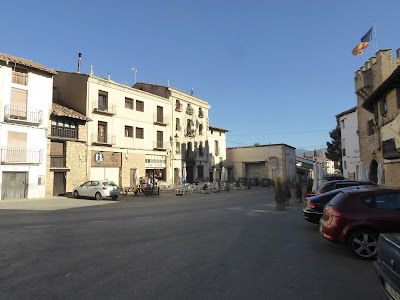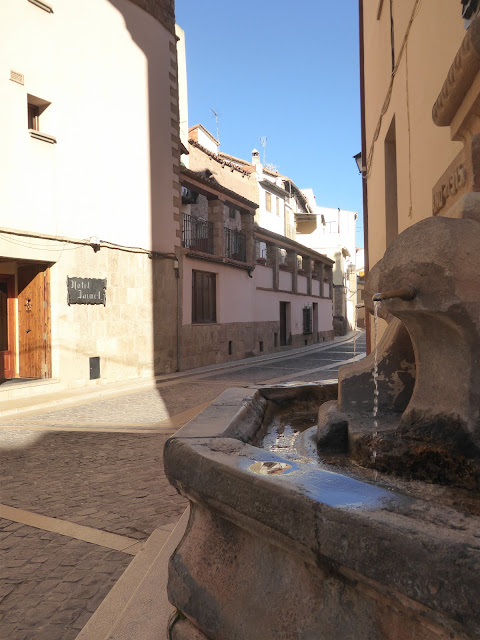A town and two pueblos in Aragon....
The Comunidad de Aragon outlined in red.
Teruel at the southern end of the Comunidad.
************************************
TERUEL
************************************
Teruel, the capital of Teruel Province, was founded in 1171 by Alfonso II in a fairly remote and mountainous location 915 meters (3,002 ft.) high. Its population of approximately 36,000 belies a bustling urban landscape that has its own distinct ambiance and charm.
To the traveler from Valencia, the town's elevation and hillside configuration are a significant change from the flat, sea-level Mediterranean metropolis. What makes it even more significant to the architectural traveler is that it is regarded as the "town of mudéjar."
"Mudéjar is the name given to Moors or Muslims of Al-Andalus who remained in Iberia after the Christian Reconquista but were not converted to Christianity...
Mudéjar also denotes a style of medieval Iberian architecture and decoration, particularly of Aragon and Castile, strongly influenced by Moorish taste and workmanship."
(WIKIPEDIA)
Mudéjar also denotes a style of medieval Iberian architecture and decoration, particularly of Aragon and Castile, strongly influenced by Moorish taste and workmanship."
(WIKIPEDIA)
The town's numerous buildings designed in this style have led the collection of historic buildings to be designated by UNESCO as a World Heritage Site
"The property comprises ten religious and secular monuments in the provinces of Teruel and Zaragoza. They include: the tower, roof, and cimborio of the Cathedral of Santa María de Mediavilla de Teruel; the tower and church of San Pedro de Teruel; the church tower of San Martín de Teruel; the church tower of Salvador de Teruel...
The Mudéjar architecture of Aragon is, on account of the formal solutions adopted and the techniques and materials of construction employed, a specific and extraordinary legacy, as well as a vivid reflection of a moment in history when three cultures with very different roots flourished together on Aragonese soil. Decorative motifs from a great variety of traditions can be seen in the ten monuments that make up this property including: Greco-Roman, Byzantine, Sassanid, Seljuq, Berber, and Visigoth among others."
(From the UNESCO World Heritage List's "Mudejar Architecture of Aragon," 1986)
There are five Mudéjar towers in all, built between the 12th-century and the 16th-century. Below, are photos of the 14th-century "El Salvador" tower.
(From the UNESCO World Heritage List's "Mudejar Architecture of Aragon," 1986)
The Church Towers
There are five Mudéjar towers in all, built between the 12th-century and the 16th-century. Below, are photos of the 14th-century "El Salvador" tower.
From a distance, another of the towers.
Catedral de Santa María de Mediavilla
Not sure how the above two photos (by others) were taken, but I think it must have something to do with ladders and lighting. The on-the-ground view provides tantalizing glimpses of the intricate painting, but this is another case of the intent being more important than the pleasure - or education - of the viewers themselves.
Street Scenes
Delegación Territorial de Teruel. Departamento de Presidencia (REGIT)
(Office of the Spanish Government in Teruel,
including a performance space.)
"TERUEL-zilla"
El edificio de ocio juvenil
(Youth Recreation Center)
y
Plaza Domingo Gascón
Mi5 Arquitectos + PKMN [pacman], Architects
2012-2015
This series of four photographs by Miguel de Guzmán
show an impressive command of the camera. I discovered them among the featured archives of one of the major international online architectural blogs. They are almost convincing: This is a unique intervention in an urban square - adding to, rather than destroying the public nature of the plaza itself. It can also been seen as an attempt to elevate the architecture of the rest of the square.
The on-the-ground reality, particularly on a cold winter day. is a bit less convincing. The overall industrial aesthetic has not aged well in the three years since the center opened. Although there is little signs of community disregard (no tagging or damage to the structure), the finishes are looking shabby. The attempts at greenery are equally unsuccessful most probably because of the amount of "hardscape" vs. "softscape". The ground-floor windows allowing views into the multi-level space are obscured with what appears to be permanent dirt and grime (plastic panels?) to the point that they seem almost irrelevant.
The overall design, essentially a below-grade building into which you must descend to enter, also works against this being a more welcoming place. And, at that, the entries seem narrow and tight - forced, rather than natural. I was unable to enter, but the little I could see through the windows had little of the excitement of the original photographs. Everything seems to have faded.
I was more than hopeful that this place might work. There is little example throughout Spain of the integration of new architecture with old, traditional with cutting-edge. The historic urban centers seem frozen in a historian's time warp, while the (more) modern edges of the cities are a hodgepodge of mainly bad 20th- and 21st-century design. There seems to be little attempt to try to merge the two in order to help keep the model of a "living" and constantly changing city alive.
So, this one gets top grades for the effort, but only middling grades for execution.
Plaza del Torico
The plaza includes two prime architectural examples of architectural Modernisme, the Spanish Art Nouveau movement. Oddly, the supports for the ground floor arcade have all been "restored" to a condition that might or might not be original. It is, at the very least, difficult to imagine why this was done, particularly given how discordant the restorations. (See also, above photo.)
Ayuntamiento
(Town Hall)
La Escalinata
(The Steps of Teruel)
José Torán de la Rad
1921
(Aerial photo by others.)


************************************
RUBIELOS DE MORA
************************************
(Photo by others.)
"Rubielos de Mora is a municipality located in the province of Teruel, Aragon, Spain. According to the 2004 census (INE), the municipality had a population of 652 inhabitants."
(WIKIPEDIA - The entire entry.)
"Rubielos de Mora, also known as Corte de Sierra has a great number of ancestral homes and notable buildings that make up its widely recognised Artistic Historic Site. (1983 Europa Nostra Prize). The preservation of its unique architecture has been one of the basic principles, making it one of the Most Beautiful Towns in Spain, for which it was granted a prize in May 2013. The name of Rubielos de Mora comes from the Latin Rubus Idoeus, due to the abundance of blackberry bushes found throughout the region which added colour to the plain."
(https://www.cittaslow.es/en/city/rubielos-de-mora/)
A QUESTION OF TRANSLATION: There is some disagreement about the blackberry attribution. Mora translates into both blackberry and mulberry in English, but more prominently as mulberry. The mulberry, however, is a deciduous tree, as opposed to the blackberry's perennial plant. So, if the above citation is to be believed, and indeed the "bushes..added colour to the plain," (no photos available) the village name would indeed seem to refer to blackberries, not mulberries.
Before you voice the criticism of "Where are the people?" in all of the photographs, the following might be of interest.
We arrived in the town at 11:15 on a brisk Thursday morning. We had a traditional almuerzo (the Spanish repast taken between breakfast and lunch) served by two friendly people in the Casa Vicente (see below). There were two other equally friendly patrons in the restaurant. That was the most people we saw in one place in the entire pueblo for our entire 2.5 hour visit. Altogether, we glimpsed perhaps a dozen people altogether. I would have literally had to hire extras to take a photo with a person.
Although there were no messy people to disrupt the pristine and perfectly preserved beauty of the place, it was actually just a bit creepy. Sort of like an abandoned, full-scale Disneyland attraction, but with exposed utility wires and a few scattered vehicles. The Walking Dead without even the walking dead.
Excolegiata de Santa María la Mayor
(Former collegiate church of Santa María la Mayor)
17th-century
At around noon, when the church bells rang, we saw the most people of the day. At least five persons walked out of their houses and proceeded to disappear into the winding alleys of the village. I almost photographed them...
Hotel los Leones and the Plaza Igual y Gil

The hotel was equally seemingly empty. We entered through the unlocked front door and proceeded to wander throughout the premises without seeing a soul. There was one room that showed signs of a previous occupant.
************************************
MORA DE RUBIELOS
************************************
"Mora de Rubielos is a municipality located in the mountainous area of the Iberian System, province of Teruel, Aragon, Spain. According to the 2009 census (INE), the municipality has a population of 1,756 inhabitants. Mora de Rubielos has a beautiful 14th-century castle. Mora de Rubielos is the capital of the Comarca of Gúdar-Javalambre."
(WIKIPEDIA - Only a portion of the long entry.)
This time, the absence of people is my doing...
This time, the absence of people is my doing...
Fuen Lozana river
Iglesia de la Natividad de Nuestra Senora (Ex Colegiata)
(Church of the Nativity of Our Lady)
Original, 14th-Century,
Major Additions and Renovations,15th- and 16th-Century
For those of us interested:
"In Christianity, a collegiate church is a church where the daily office of worship is maintained by a college of canons; a non-monastic or "secular" community of clergy, organised as a self-governing corporate body, which may be presided over by a dean or provost. In its governance and religious observance a collegiate church is similar to a cathedral, although a collegiate church is not the seat of a bishop and has no diocesan responsibilities.
In a collegiate church or chapel, as in a cathedral, the canons or fellows are typically seated separately from any provision for a lay congregation, in quire(sic) stalls parallel with the south and north walls facing inwards rather than towards the altar at the eastern end.
(WIKIPEDIA)
Castillo de Moro
Begun in the14th-Century
(Photo by others.)






















































































































